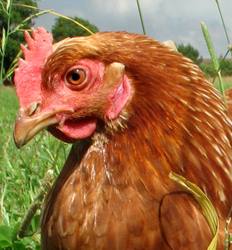
CHICKENS
Chicken is the most common type of poultry in the world, and is prepared as food in a wide variety of ways, varying by region and culture.
Modern varieties of chicken such as the Cornish Cross, are bred specifically for meat production, with an emphasis placed on the ratio of feed to meat produced by the animal. The most common breeds of chicken consumed in the US are Cornish and White Rock.
Chickens raised specifically for food are called broilers. In the United States, broilers are typically butchered at a young age. Modern Cornish Cross hybrids, for example, are butchered as early as 8 weeks for fryers and 12 weeks for roasting birds.
Capons (castrated cocks) produce more and fattier meat. For this reason, they are considered a delicacy and were particularly popular in the Middle Ages.

FREE RANGE EGGS
Free-range eggs are eggs produced using birds that are permitted to
roam freely within a farmyard, a shed or a chicken coop. (Eggs from indoor-only chickens might also be labelled cage-free or bard-roaming.) This is different from factory-farmed birds that are typically enclosed in battery cages. The term "free-range" may be used differently depending on the country and its law.
Legal standards defining "free range" can be different or even non-existent depending on the country. For example, the U.S. Department of Agriculture requires only that the bird spends part of its time outside, and allows egg producers to freely label these eggs as free-range. Many producers will label their eggs as cage-free in addition to or instead of free-range. Recently, US egg labels have expanded to include the term "barn-roaming," to more accurately describe the source of those eggs that are laid by chickens who do not range freely but are confined to a barn instead of a more restrictive cage.
Cage-free egg production includes barns, free-range and organic systems. In the UK, free-range systems are the most popular of the non-cage alternatives, accounting for around 44% of all eggs in 2011, compared to 4% in barns and 3% organic. In free-range systems, hens are housed to a similar standard as the barn or aviary. In addition, they have constant daytime access to an outside range with vegetation. In the EU each hen must have at least 4 square metres of
space

CHICKEN HISTORY
The chicken (Gallus gallus domesticus) is a domesticated fowl, a subspecies of the Red Junglefowl. As one of the most common and widespread domestic animals with a population of more than 24 billion in 2003, there are more chickens in the world than any other species of bird. Humans keep chickens primarily as a source of food, consuming both their meat and their eggs.
The traditional poultry farming view of the domestication of the chicken is stated in Encyclopędia Britannica (2007): "Humans first domesticated chickens of Indian origin for the purpose of cockfighting in Asia, Africa, and Europe. Very little formal attention was given to egg or meat production... " Recent genetic studies have pointed to multiple maternal origins in Southeast, East, and South Asia, but with the clade found in the Americas, Europe, the Middle East and Africa originating in the Indian subcontinent. From India, the domesticated chicken was imported to Lydia in western Asia Minor, and to Greece by the fifth century BC. Fowl had been known in Egypt since the 18th Dynasty, with the "bird that gives birth every day" having come to Egypt from the land between Syria and Shinar, Babylonia, according to the annals of Tutmose III.
The domestic chicken is descended primarily from the Red Junglefowl (Gallus gallus) and is scientifically classified as the same species. As such it can and does freely interbreed with populations of red jungle fowl. Recent genetic analysis has revealed that at least the gene for yellow skin was incorporated into domestic birds through hybridization with the Grey Junglefowl (G. sonneratii).
The traditional poultry farming view is stated in Encyclopędia Britannica (2007): "Humans first domesticated chickens of Indian origin for the purpose of cockfighting in Asia, Africa, and Europe. Very little formal attention was given to egg or meat production... " In the last decade there have been a number of genetic studies. According to one study, a single domestication event occurring in the region of modern Thailand created the modern chicken with minor transitions separating the modern breeds. However, that study was later found to be based on incomplete data, and recent studies point to multiple maternal origins, with the clade found in the Americas, Europe, Middle East, and Africa, originating from the Indian subcontinent, where a large number of unique haplotypes occur. It is postulated that the Jungle Fowl, known as the "bamboo fowl" in many Southeast Asian languages, is a special pheasant well adapted to take advantage of the large amounts of fruits that are produced during the end of the 50 year bamboo seeding cycle to boost its own reproduction. According to Daniel H. Janzen of the University of Pennsylvania, in domesticating the chicken, humans took advantage of this prolific reproduction of the jungle fowl when exposed to large amount of food.
It has been claimed (based on paleoclimatic assumptions) that chickens were domesticated in Southern China in 6000 BC. However, according to a recent study, "it is not known whether these birds made much contribution to the modern domestic fowl. Chickens from the Harappan culture of the Indus Valley (2500-2100 BC), in what today is Pakistan, may have been the main source of diffusion throughout the world." A northern road spread the chicken to the Tarim basin of central Asia. The chicken reached Europe (Romania, Turkey, Greece, Ukraine) about 3000 BC. Introduction into Western Europe came far later, about the 1st millennium BC. Phoenicians spread chickens along the Mediterranean coasts, to Iberia. Breeding increased under the Roman Empire, and was reduced in the Middle
Ages. Middle East traces of chicken go back to a little earlier than 2000 BC, in Syria; chicken went southward only in the 1st millennium BC. The chicken reached Egypt for purposes of cock fighting about 1400 BC, and became widely bred only in Ptolemaic Egypt (about 300 BC). Little is known about the chicken's introduction into Africa. Three possible ways of introduction in about the early first millennium AD could have been through the Egyptian Nile Valley, the East Africa Roman-Greek or Indian trade, or from Carthage and the Berbers, across the Sahara. The earliest known remains are from Mali, Nubia, East Coast, and South Africa and date back to the middle of the first millennium AD. Domestic chicken in the Americas before Western conquest is still an ongoing discussion, but blue-egged chickens, found only in the Americas and Asia, suggest an Asian origin for early American chickens.
A lack of data from Thailand, Russia, the Indian subcontinent, Southeast Asia and Sub-Saharan Africa makes it difficult to lay out a clear map of the spread of chickens in these areas; better description and genetic analysis of local breeds threatened by extinction may also help with research into this area.
.
YOUTUBE
LINKS
http://en.wikipedia.org/wiki/Chicken
http://www.telegraph.co.uk/news/uknews/1534371/How-the-egg-inspectors-spotted-the-free-range-label-fraud.html
http://www.agriblog.co.uk/?p=102





